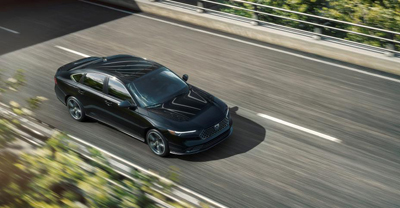The Honda Accord outperformed other midsize cars in the updated moderate overlap front crash test, earning a rare good rating in the new, challenging evaluation focused on rear-seat protection.
Among the other six midsize cars tested, the Subaru Outback earned an acceptable rating. The Nissan Altima and Toyota Camry were rated marginal. The Hyundai Sonata, Kia K5 and Volkswagen Jetta were rated poor.
“In most of the midsize cars we tested, the rear dummy slid forward, or ‘submarined,’ beneath the lap belt, causing it to ride up from the pelvis onto the abdomen and increasing the risk of internal injuries,” IIHS President David Harkey said. “In the three poor-rated vehicles, measurements taken from the rear dummy also indicated likely injuries to the head or neck as well as to the chest.”
IIHS launched the updated moderate overlap front test last year after research showed in newer vehicles the risk of a fatal injury is now higher for belted occupants in the rear than for those in front. This is not because the rear seat has become less safe. Rather, the front seat has become safer because of improved airbags and advanced seat belts that are rarely available in back. Even with these developments, the back seat remains the safest place for young children, who can be injured by an inflating front airbag.
To encourage manufacturers to improve rear-seat protection, the updated test adds a dummy in the back seat behind the driver. The driver dummy is the size of an average adult man. The rear dummy is the size of a small woman or 12-year-old child. IIHS researchers also developed new metrics that focus on the injuries most frequently seen in back-seat passengers.
For a vehicle to earn a good rating, there can’t be an excessive risk of injury to the head, neck, chest or thigh, as recorded by the second-row dummy. The dummy should remain correctly positioned during the crash without submarining. The head should also remain a safe distance from the front seatback and the rest of the vehicle interior, and the shoulder belt should remain on the shoulder, where it is most effective. A pressure sensor on the rear dummy’s torso is used to check the shoulder belt position during the crash.
As in the original test, the structure of the occupant compartment must maintain adequate survival space for the driver, and measurements taken from the driver dummy shouldn’t show an excessive risk of injuries.
All seven midsize cars provided good protection in the front seat. However, measurements indicated a slightly higher risk of injuries to the right leg or foot of the driver in the good-rated Accord.
The Accord provided stellar protection in the back seat. Measurements taken from the rear dummy showed no heightened risk of injuries, and the rear restraints did a good job controlling the dummy’s motion.
In contrast, submarining was a problem for the poor-rated K5 and Sonata, while in the Jetta the rear passenger’s head came too close to the front seatback. In all three poor-rated cars, measurements taken from the rear dummy indicated likely injuries to the head or neck and chest and excessive belt forces. In the K5 and Sonata, the rear shoulder belt also moved off the shoulder toward the neck.
In both the marginal-rated Altima and Camry, the rear dummy submarined beneath the lap belt, and the shoulder belt moved off the shoulder toward the dummy’s neck. In the Altima, injury measurements also indicated a moderate risk of head or neck injuries for the rear passenger.
Measurements taken from the rear dummy in the acceptable-rated Outback didn’t show any elevated injury risks. However, the dummy submarined beneath the lap belt, and its head came close to the front seatback during the crash, increasing the likelihood of abdominal and head injuries. After impact, the dummy’s head also slipped between the side curtain airbag and contacted the rear window door trim as the dummy rebounded.
Source: IIHS









